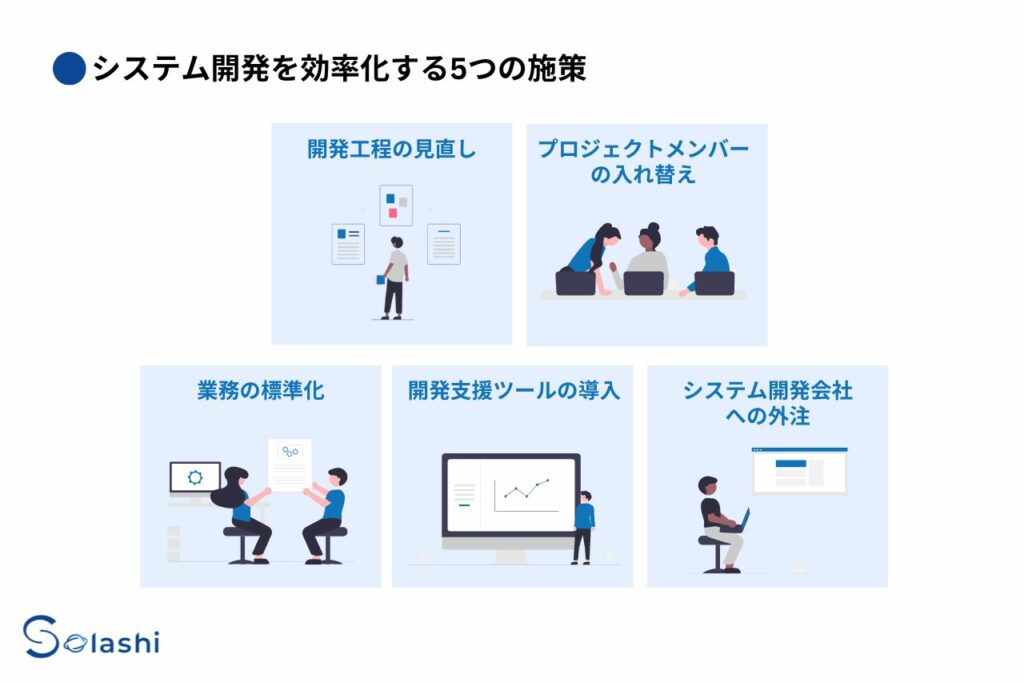“Want to improve system development efficiency?”
“Current project is not running smoothly?”
If you have such concerns, we will introduce key points to enhance system development efficiency. Understand the causes of system development failures and take appropriate measures.
In the latter part of the article, we will also introduce the importance of efficiency and a formula to measure current productivity, so be sure to check it out.

Akira Shimazoe
CEO of Solashi Japan LLC. Engaged in the development and operation of internal systems at Suntory. Founded Yper Inc., serving as CTO and CPO, contributing to product launch and growth.
What is System Development Efficiency?
System development efficiency means improving the productivity of development tasks.
By effectively utilizing development resources, eliminating unnecessary processes, and prioritizing high-value tasks, efficiency can be improved.
If more results can be achieved in the same amount of time, it can also lead to increased revenue. Not only in system development but also in general business operations, efficiency improvement is a crucial initiative for companies.
Four Causes of Low System Development Efficiency
The following are the causes of decreased system development efficiency:
- There are unnecessary development processes
- Developers lack the necessary skills
- Each process is too dependent on specific individuals
- Development is progressing without clear priorities
Before trying to improve system development efficiency, first, identify the causes of inefficiency. Let’s analyze these four causes in detail.
There Are Unnecessary Development Processes
Having unnecessary development processes reduces work efficiency.
<Examples of Unnecessary Development Processes>
- Too many manual steps lead to human errors
- Different persons handle each development phase, causing miscommunication
- Lack of standardized workflows results in inefficiencies
- Complex internal approval flows delay decision-making
Even if the final product is the same, the development process varies depending on engineers and teams.
A process with unnecessary development steps can create various inefficiencies and lower development efficiency.
Developers Lack Necessary Skills
If a development company or engineer lacks sufficient development skills, the risk of the following issues increases:
<Examples of Issues Due to Lack of Developer Skills>
- Completed programs contain missing or incorrect functionalities
- Struggling to understand the contents of the specifications document
- Missing defects during testing
When these troubles occur, it takes time to make corrections and adjustments. As a result, project schedules get delayed, lowering overall efficiency.
Each process is overly dependent on specific individuals
Over-reliance on specific individuals in each process can also hinder efficiency.
“Over-reliance” refers to a state where only a specific person understands how to perform a task or process. If that person is absent, others must figure everything out from scratch. This can halt development progress and make it difficult to respond to inquiries.
In particular, unit testing and integration testing are often handled by developers themselves, making them prone to over-reliance. Therefore, special attention is needed.
Proceeding with development without clear priorities
If development proceeds without clear task priorities, the overall project flow may be disrupted.
Unclear priorities often result in situations where lower-priority tasks are tackled first while high-priority tasks are postponed.
As a result, there is less time allocated for essential tasks, which may disrupt the development schedule. Additionally, delaying necessary tasks can stall progress on subsequent processes.
5 Strategies to Improve System Development Efficiency

Here are some effective strategies for improving system development efficiency.
- Reviewing the development process
- Replacing project members
- Standardizing operations
- Introducing development support tools
- Outsourcing to a system development company
Let’s take a closer look at these five strategies.
Reviewing the development process
Take a critical look at the development process and actively eliminate inefficient tasks.
Even tasks that seem routine may not be as essential when examined from a broader perspective.
System development follows these key stages:
[System Development Stages]
- Requirements Definition
- Design
- Implementation
- Testing
- Release
- Operation & Maintenance
Before starting development, it is crucial to review the development process with the project members and maintain an awareness of eliminating waste, inefficiencies, and inconsistencies.
A common issue is hesitating to revisit previous steps after moving forward, which results in prolonged development timelines.
There may be cases where necessary requirements are not well-organized, or where going back a step requires obtaining agreement from relevant stakeholders. In such cases, it is important to intentionally rewind the process and build decisions appropriately.
Additionally, check whether there are routine tasks such as meetings without agendas or formalized regular meetings that lack clear objectives.
Replacing project members
If a lack of skills among project members is identified during development, consider replacing personnel flexibly.
Each engineer has different levels of experience and areas of expertise, so reorganizing the team based on these factors is essential.
By assigning each engineer a role that matches their abilities, the overall efficiency of the project can be improved.
Standardizing operations
To prevent inefficiencies caused by reliance on specific individuals, standardizing operations is also crucial.
Standardization is the opposite of individual dependence, ensuring that any team member can perform tasks and achieve the same results.
Thorough information sharing and establishing frameworks for coding standards can help achieve this.
By unifying decision-making criteria and workflows among team members, variations in development processes and deliverable quality are minimized, leading to more efficient work execution.
Introducing development support tools
Another effective approach is leveraging development support tools.
By utilizing the following types of tools, it is possible to automate and streamline various development tasks.
Examples of Development Support Tools:
- IDE (Integrated Development Environment tools)
- Task and progress management tools
- Test automation tools
- Code review automation tools
Additionally, by preventing human errors, it is possible to expect improvements not only in efficiency but also in quality.
Recently, a variety of tools with different features have been developed, so it’s important to choose the one that best fits your company or project.
Outsourcing to a system development company
If your company cannot provide the development resources or appropriate personnel, outsourcing to a system development company is an option.
If you are unsure whether to outsource development or handle it in-house, please refer to this article: Is outsourcing system development the best option? A thorough comparison of the pros and cons with in-house development.
By entrusting development to experienced engineers, you can efficiently move the project forward.
If you are considering outsourcing to a system development company, please consult with us at Solashi Co., Ltd.
We are a system development company based in Hanoi, Vietnam, and we hire students from top universities such as Hanoi University of Science and Technology, which is renowned for its engineering programs.
We also have PMs with experience launching businesses in Japan, providing support for cost-effective system development.
We meet your needs with high technical capabilities backed by stringent hiring standards, so please don’t hesitate to reach out to us.
Japanese PMs Handle Communication
Looking for an Offshore Development Company
For such individuals, we recommend Solashi’s Vietnam offshore development
Why is the efficiency of system development important?
Why is the efficiency of system development important? There are mainly three reasons:
- It leads to an increase in profit margins.
- It allows quick reflection of market trends.
- It helps prevent resource shortages.
Leads to increased profit margins
One of the reasons why improving system development efficiency is important is because it leads to an increase in profit margins.
Whether your in-house project team is developing or you’re outsourcing, efficiency directly impacts the reduction of labor costs. If unnecessary labor costs can be eliminated, it leads to improved profit margins.
Quick reflection of market trends
Another reason why system development efficiency is important is that it allows market trends to be reflected quickly.
Companies that streamline their system development processes have more resources available, allowing them to quickly incorporate market trends into their development.
If there is ongoing availability, resources can be allocated to learning new technologies that are constantly being updated. This can lead to a more dynamic development environment and improve technical capabilities.
If you are a vendor, introducing new technologies earlier than your competitors can create differentiation in a highly competitive market.
Prevention of resource shortages
By improving system development efficiency, the burden on engineers can be reduced, preventing resource shortages.
If inefficient system development occurs with limited personnel, progress will slow down. As a result, there is a risk of increasing the load on engineers, which could lead to higher turnover rates.
By improving system development efficiency and progressing projects smoothly, the burden on engineers can be reduced, and staff retention can be maintained.
Related article: What are development resources? Causes of shortages, impacts, and future measures explained
Formulas and Metrics to Measure System Development Efficiency
The goal of improving system development efficiency is to increase productivity. Below are the formulas and metrics used to quantify and evaluate productivity.
The formula for calculating productivity is “Output ÷ Input”.
This formula shows how much output or profit was generated relative to the input, such as labor, time, or costs.
The productivity measure varies depending on what is substituted for output and input. For example, it could be the profit per person or the production per hour.
Two common productivity metrics are as follows:
- Added value labor productivity
- Physical labor productivity
These metrics will be explained, but even when productivity is quantified, it is not always easy to determine whether efficiency has actually improved.
We will also discuss the reasons behind this and provide guidelines for evaluating system development efficiency more comprehensively.
Added Value Labor Productivity
Added value labor productivity is a metric that measures how much added value is generated per person or over a certain period of time.
Added value is calculated by subtracting the costs such as labor and materials from sales revenue. The formula is as follows:
- Added value labor productivity = Added value ÷ Labor volume
If you are a vendor who can assign a price to your deliverables, you can calculate productivity using this formula. However, note that development efficiency does not necessarily correlate directly with profit.
Limitations of Added Value Labor Productivity
Efficiency improvements that allow handling more projects can sometimes lead to increased productivity.
However, if there is a history of similar projects and accumulated know-how, it is true that more projects can be handled smoothly.
System development projects vary significantly in their characteristics. As a result, it is not possible to standardize the resources required for each one. Additionally, profit margins are influenced by market value and prices. It is difficult to determine whether profit increases are directly due to improved development efficiency.
In the case of developing your company’s web services, apps, or internal business systems, quantifying profit becomes challenging.
Profit generation is influenced by factors such as marketing effectiveness and efficiency improvements in systems outside of development. It is difficult to quantify the profit generated purely from the developed deliverables.
Physical Labor Productivity
Physical labor productivity is a metric that measures the physical production efficiency per person or over a set period of time.
This metric expresses productivity based on quantities or numbers, showing how much output is generated. The formula is as follows:
- Physical labor productivity = Production volume ÷ Labor volume
Limitations of Physical Labor Productivity
In system development, metrics such as the number of design documents created, modules developed, or test cases executed can be considered productivity.
However, there is a significant difference in the difficulty level of these tasks, and treating them as equivalent achievements would not yield an accurate measure of productivity.
For example, in the testing process, treating tasks that take a few minutes to complete the same as those that take several hours is not realistic.
If production volumes can be assigned a nominal value based on difficulty, it might be possible to calculate productivity closer to reality.
However, accurately calculating a large number of tasks is difficult and time-consuming. Especially for design and manufacturing, where more time is spent on thinking and research than on actual work, quantifying them becomes even harder.
Additionally, the assumption that productivity increases with production volume does not apply well to system development.
Even if the number of design documents, modules, or test cases increases unnecessarily, productivity would rise, while the actual efficiency or quality may be ignored.
Indicators for System Development Efficiency
In system development, it is difficult to find clear metrics to measure efficiency improvement. However, it is possible to evaluate efficiency holistically by looking at changes in the following aspects:
- Number of bugs or rework incidents
- Progress status
- Frequency of delays in starting subsequent tasks due to postponing must-do tasks
- Time taken to start tasks after they are identified
- Quality of design documents, modules, etc.
- Frequency of delays due to lack of information sharing
- Working hours, frequency of overtime
- Whether the source code is easy to maintain for future operation and maintenance
Efficiency improvement in development is focused on how quickly quality deliverables can be produced while maintaining quality.
It may be useful to begin by reviewing the above points carefully and conducting in-depth interviews with the development team.
Case Studies of System Development Efficiency Improvements
Finally, let’s look at some case studies where system development efficiency improvements were successfully implemented.
One manufacturer was urgently developing a system to centralize information that had been managed manually.
The solution they implemented was a low-code web application auto-generation tool, which facilitated faster development.
By utilizing development tools, they were able to standardize development skills and adopted technologies. This led to a successful reduction in lead time and established a system to improve product quality and factory productivity.
Another case comes from a distribution company that needed to develop core systems and in-house development systems on a tight schedule and frequent basis.
By introducing development tools and adopting agile development, they were able to significantly shorten the development period. Ideas from the field were incorporated, accelerating the digital transformation (DX) process.
For those interested in improving system development efficiency, please contact our company, Solashi Co., Ltd.
We actively propose ways to improve efficiency and also support flexible agile development approaches to move the development forward.
System Development Efficiency with Solashi
If you feel that your system development efficiency is poor, it is important to first identify the causes that are hindering efficiency based on your current situation. Let’s implement the appropriate measures for the challenges you are currently facing.
“We don’t have the resources to handle in-house system development”
“Current projects aren’t progressing smoothly”
If you are facing such challenges, please let us at Solashi Co., Ltd take care of it. We actively propose services, frameworks, and libraries to improve development efficiency.
This enables us to proceed with development swiftly in response to your needs.
Whether it’s a new inquiry or if you are facing difficulties with existing outsourcing, feel free to contact us at Solashi Co., Ltd for assistance.
Akira Shimazoe Representative of Solashi Japan LLC. Born in April 1989 in Fukuoka Prefecture. Graduated from the Graduate School of Information and Mathematical Sciences at Osaka Prefecture University. Joined Suntory System Technology Co., Ltd., an IT subsidiary of Suntory Holdings, in 2014. Broadly responsible for the development, operation, and implementation of vending machine delivery management, efficiency improvements, and sales management systems. Founded Yper Inc. in 2017, serving as CTO and CPO. Contributed to the launch and growth of the app-linked delivery bag "OKIPPA." Selected for Toyo Keizai's prestigious "Amazing Venture 100" and Forbes' "Forbes 30 Under 30 Asia 2019."

 日本語
日本語
